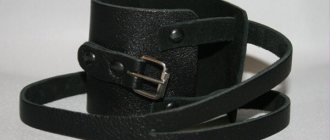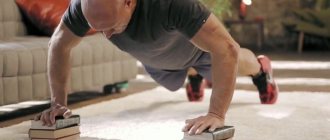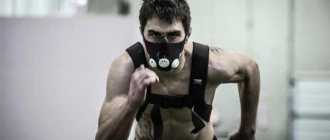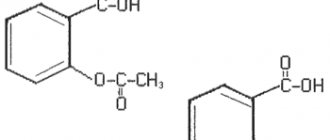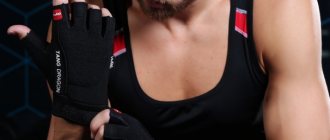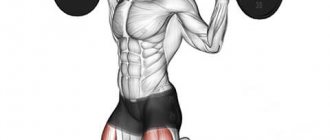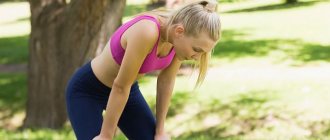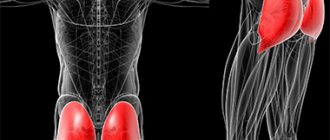What it is?
When performing squats, a large load is placed on all joints involved in this exercise. Squat wraps help protect your knees from injury, which is their original function. They stretch, and when wound around the knees, they are stretched strongly so that they squeeze the kneecap as tightly as possible.
In addition to their protective function, they have an auxiliary effect, helping the athlete return from the lower phase. The secret lies in the elasticity of the material. When standing, the bandages remain in a contracted position. When an athlete squats, they stretch and, as a result, push the body upward.
Squat technique
You can squat on both legs, on one, with support, with weight, with arms raised: this is not a complete list of ways to perform the exercise. Despite the differences in execution, all types of techniques have similar biomechanics. So, more about the technique of doing squats.
General biomechanics
In general, the squat technique looks like this:
- Place your feet shoulder-width apart. Position your feet so that your toes are slightly turned out to the sides.
- Point your knees and toes in one direction. Shift your body weight to your heels.
- Press your feet firmly to the floor and do not lift them throughout the entire exercise.
- If you are performing a squat without additional weights, you can hold your hands in front of you (this is the easiest way to maintain balance), put them behind your head, or cross them in front of your chest.
- Keep your lower back in a “boat” position with a slight arch. Do not round it, including in the thoracic region.
- Try not to lean forward. Watch your posture.
- Do not bring your knees in or spread them out to the sides when rising from a low position. The knees should “look” in the same direction as the feet. Also try not to bring your knees forward beyond the level of your toes.
- Take a deep breath at the beginning of the exercise. In the future, when rising, you need to exhale, when lowering, inhale.
- You need to lower yourself at least until your thighs are parallel to the floor. Even deeper is better, although this depends on the purpose of the exercise.
- There is no need to straighten your legs all the way at the top point. Just before reaching full straightening, immediately begin moving downwards.
Equipment
Additional equipment is needed for squats with weights (dumbbells, kettlebells, barbells).
For strength training we use:
- Elastic bandages for knee and wrist joints.
- Belt.
- Special overalls for squats (used only in competitive powerlifting).
Powerlifting overalls are used only in conjunction with bandages. They prevent you from bending your back while squatting with weights. The cut of the legs helps to start the upward movement from the lowest point. The overalls can increase the result in squats by tens of kilograms.
© concept w — stock.adobe.com
To perform squats in a gymnastics complex for pregnant women or as part of physical rehabilitation after injuries to the spine or limbs, a gymnastic pole (stick) is used to reduce the load. The athlete places it vertically in front of him and uses it as a support.
To perform Bulgarian squats, you need a bench or other support. Leaning into it with the toe of your outstretched leg, you need to squat down so that the thigh of your supporting leg is parallel to the floor.
When squat bands are not needed
The use of this element is far from mandatory during training. It is focused on pre-competition preparation and the competition itself. Or at least serious weights. You shouldn't wrap bandages if your squat is 50 x 3.
In normal training, they are practically not needed unless serious weights are used. Or the athlete is engaged in powerlifting and is now going through a strength cycle, trying to set his maximum for one time.
Should beginners use squat bands? Definitely not. At the initial stage of training, the loads are small, and even if they are difficult for a person, they have practically no effect on the joints.
Bandages on the knees cut
Knee wraps are painful. It always hurts - from the moment when the knees are wrapped, ending with the moment when the bandages are removed; it hurts not because the athlete is doing something wrong, but because the bandages are pressing hard. Of course, this is just pain in the skin, and it is not accompanied by serious injuries, but to a beginning athlete, the painful effects of bandages can seem very significant. If you can’t distract yourself from this feeling, then it’s easy to forget about the correct squatting technique. Bandages leave bruises, bruises, and sometimes the skin bursts a little. Over time, the skin gets used to it and the pain and damage go away.
R: It took me about two months to get used to the bandages. It was very painful, at first I could not bring myself to sit down, and from the strong winding I was generally terrified and could hardly stand on my feet, even without squatting. The skin reacted painfully, there were constant bruises. Now it usually turns slightly pink and only very rarely leaves some minor bruising.
R'2016Now only the first 3-4 workouts in bandages hurt. Then it hurts too, but somehow you don’t pay attention.
Kinds
Squat bands are divided into several types based on their hardness. You should not buy Chinese-made equipment. Among the trusted companies are the following giants:
- INZER.
- METAL.
- TITAN.
These are the best manufacturers, tested by more than one thousand athletes.
For beginner bodybuilders, the softest ones are suitable, the maximum increase in weight being lifted is no more than 7 kg. Due to their elasticity and low rigidity, the bandages allow you to continue to hone your squat technique without harming your joints. They cannot be used if the barbell weighs more than 150 kg.
Expert opinion
Medium hardness – for more seasoned athletes. This is the most popular type of sports bandages. Suitable for those whose squatting technique has already been formed and established. The weight gain, with the tightest winding, will be up to 20 kg on the bar.
Hard ones are intended mainly for performing athletes; they allow you to add up to 25 kg to the weight on the bar. They strongly compress the leg, constrain the joints, fixing them.
How bandages help athletes
Many powerlifters use wrapping without any understanding of its actual purpose. The idea is to locally improve blood supply at the site where the bandages are applied and increase the stability of the joint.
For squats, knee bands are used almost constantly, since just one turn of the band around this joint allows the athlete to lift a weight of 4 kg more than usual. A standard two-meter bandage is wound in several turns and already gives from 25 to 35 kg of additional weight for lifting.
The difference between knee pads and squat bandages
Knee pads are designed for sports and provide joint compression. They have a warming effect, due to which protection from injuries and diseases is achieved. They are not designed for complex exercises with heavy weights. Only squat bandages are suitable for this, the rigidity of which is regulated by the degree of stretch when winding.
Knee pads do not provide any increase in weight on the bar, while bands significantly increase the athlete's results. Knee pads are designed to warm up the knee joints during and before exercise.
Wrist bandage for bench press
With this same device, things are a little different. Wrist wraps are used for bench press, French press and as additional protection during squats.
They help preserve the athlete’s wrist joints and protect the ligamentous and articular apparatus from sprains or dislocations. The products also help increase working weight and, as a result, strength indicators. When using clamps, a compression wrap can be provided, which increases grip strength.
Benefits and harms
The equipment provides undeniable assistance in maintaining balance during squats with heavy weights. This allows the athlete to concentrate on the exercise and not be distracted. Weight gain is associated with increased stability of banded knee joints. By tightening this area, an increased temperature occurs and blood supply improves.
The main advantage is the ability to take more weight than usual. The athlete's balance control functions are removed, and all his strength is spent on lifting the pressing weight.
Disadvantages include the possibility of over-stretching the knee. This risks damaging the kneecap, especially if hard bandages are used, due to the close contact of the bone surfaces during the squat. Not recommended for use for joint and tendon injuries.
The advantages and disadvantages balance each other.
Negative aspects of using bandages
The disadvantages of squat bands relate to both physical and psychological aspects of the powerlifter's condition. In physical terms, discomfort can be caused by an overly tight bandage, which can even cause injury to the kneecap itself. The cause of damage in this case is the movements of the bones in the joint that are in too close contact, which are produced when it opens and closes.
Psychological dependence is expressed primarily in getting used to lifting heavy weights only with the use of bandages. Athletes call this a kind of “cheating,” which allows them to overcome “dead zones” and maximally load the muscles.
Professionals do not recommend using bandages on an ongoing basis. Constant use of bandages leads to the fact that the athlete is no longer able to lift similar heavy weights due to a combination of physical and psychological problems.
Contraindications
It is prohibited to use the winding for persons with joint or tendon injuries. This can lead to complications. You need to wrap it right before the approach and remove it immediately after finishing the squat.
Prolonged wearing is bad for the knee joints, seriously reducing their wear resistance. This entails injuries that require extensive rehabilitation. The resulting injuries will deprive the athlete of the opportunity to train the lower body for a long time, and indeed to go outside in general. You will have to stay at home most of the time.
Nuances
It is necessary to mention that bandaging protects against damage to the ligament. And in most cases you have to choose between two evils. Some athletes have weak ligaments, so it is better for them to use a bandage. If the ligaments are healthy, it is better to avoid using it.
Recommendations
You shouldn’t give up using bandages completely. But work with them should be limited to the maximum. You should only wrap your knees before the heaviest approaches. Additionally, it weakens the hamstrings. Martial artists know this very well and practically do not use such taping.
The bandage should fit tightly to the leg and securely fix the knee. In this case, it will perform its main function - protecting the ligaments. Immediately after completing the approach, the bandage should be removed; you should not walk around in it for half the workout.
Tips for choosing squat wraps and knee pads
It is important to be able to choose the right equipment based on the characteristics of your own body and tasks.
Size and manufacturer
Many companies are engaged in the production of medical, sports knee pads, and knee bandages. Preference should be given to trusted manufacturers with many reviews about their products. This makes it easier to form a clearer idea of the product.
In the case of knee pads, you need to choose German brands, one of them is Otto Bock. They were originally developed as an aid for all sports activities. It was planned that the equipment would eliminate injuries and prevent the development of existing injuries. Mainly used when running and jumping, perfectly covering the knee joint from all sides.
The size is selected so that the product sits tightly on the leg, tight, squeezing the leg.
There is no need to rush into making a choice. The training experience and goal of the athlete play a key role. If bandages are needed only to prevent injuries, you need to take the softest ones, they are up to 150 kg. If competitions are coming up, the choice falls on options of medium hardness or hard.
An excellent manufacturer of compression bandages is TITAN. Size 180–200 cm, it is necessary to wind it, stretching it strongly, otherwise there will be no effect.
Price
The price of inventory primarily depends on the brand and the location of the manufacturer’s factories. The cost varies from 180 rubles per piece of low hardness.
Knee pads are more expensive - from 550 rubles per pair, but they also have wider functionality.
When do they start bandaging your knees?
If you are going to do equipment lifting, then sooner or later this question will arise. Starting from a certain (adequate, basic) level of training, it is worth training in bandages - this will make it possible to work with more weight, which is good for developing strength. Here, as usual, everything is quite individual - when exactly, what weight, and so on.
R'2013On the squat I use bands starting from 140-160 kg (depending on the severity of the workout as a whole). When there are larger weights ahead, I start earlier (140-150). The limit without bandages for me is 165kg.
How to use it correctly
There is a certain set of rules that must be followed to achieve maximum results.
Preparation
At the beginning of your workout, you need to set aside 15 minutes for a good warm-up. Ignoring this point can lead to irreparable consequences. I think every athlete is familiar with the video where a bodybuilder was injured due to his own stupidity. Before a heavy approach, you need to perform a warm-up with 15 repetitions in it. This activates blood circulation.
Correct leg position
An athlete facing a difficult approach sits on a chair and extends one leg forward.
Bandaging technique
Another person unwinds the bandage, takes it by the edge, stretches it as much as possible, and places it just below the knee. Then it begins to make turns, constantly stretching and rising slightly above the joint. When a small piece remains, it is threaded under one of the turns. This method is called a spiral.
Cross. The initial stage is the same as in the previous method. When the bandage is above the knee joint, winding begins in the opposite direction, only in a strip across the entire knee. Then back up with an overlapping strip. The end is fixed under one of the turns.
You can wind it yourself, but the quality of the winding will be worse.
How to put on narrow knee pads
Very easy to put on, just like socks. To do this, you do not need to sit on a chair, the help of another person. The elastic design compresses the joint, but with little force. This allows you to wear them for a long time without taking them off.
Types of bandages and methods of care
Bandages suitable for athletes are made from elastin, a special fabric with rubber threads. Elastic bandages are tightly fixed to the surface being wrapped and have high stretch rates. According to the degree of elasticity, bandages are divided into three types:
- With low elasticity. Stretches up to 40% of its own length.
- With medium elasticity. 100% stretchable (twice).
- With high elasticity. Stretches 150% (three times).
Cotton bandages are more pleasant for the skin, but many athletes choose synthetic options for their durability. It is quite easy to recognize unnatural devices: the surface will be too shiny compared to cotton products. Washing bandages made of any fabric is allowed only in cold water with gentle powders. Do not wash bandages in a machine or wring them out after washing.
The product is dried in a straightened state without using an iron. Storage is allowed in rolled form. When used correctly, squat wraps last on average about 5 years.
